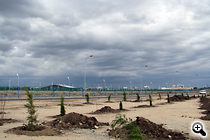 A grandiose project is rising in a sleepy corner of Central Asia, where southeastern Kazakhstan meets northwestern China. Officials in Astana hope the multi-billion dollar initiative can transform a patch of desert into an engine of growth.
A grandiose project is rising in a sleepy corner of Central Asia, where southeastern Kazakhstan meets northwestern China. Officials in Astana hope the multi-billion dollar initiative can transform a patch of desert into an engine of growth.
The Kazakhstani side of this border area – called Korgas in Kazakh, Khorgos in Russian and Huoerguosi by the Chinese – is already abuzz with activity. The plan calls for establishing a free trade zone straddling both sides of the border, attracting not just traders but also high-end tourists eager to shop in what is slated to become a set of luxury outlet malls. Underscoring its vast scope, the Khorgos International Center of Boundary Cooperation is not scheduled to open until 2018.
Located in the shadow of the Dzungarian Alatau Mountains, the free trade zone is envisioned as the centerpiece of Astana's industrialization strategy. Trying to emulate the Asian "tiger" economies, Kazakhstan aspires to become a "Central Asian snow leopard." The development of the trade and manufacturing sectors are central elements in Astana's plan. If all goes well, the free-trade zone will help Kazakhstan avoid "Dutch disease," an economic condition in which an over-reliance on energy exports stifles the development of a country's other economic sectors.
The Kazakhstani zone will encompass 185 hectares, as opposed to 343 hectares on the Chinese side. It will contain an international business center; a trade zone; freight terminals; an airport; a tourism center; sports facilities, including a football stadium; seven five-star hotels with a capacity of 5,000 guests; and a cultural zone replete with exhibition centers, art galleries and an ethnographic park.
Currently, it takes a leap of the imagination to visualize traders and tourists flocking to this dusty outpost in the Saryesik-Atyrau desert. But Astana and Beijing hope to lure visitors with a visa exemption: citizens of any country will be permitted to remain in this closed-off sector the size of about 500 football fields for 30 days without visas.
Promoters hope to drum up business from beyond Kazakhstan and China, initially eyeing entities from Russia and other Central Asian states. Officials say that the free-trade zone will offer competitive perks to attract businesses. Details of the perk-plan have yet to be developed.
The free-trade zone is conveniently situated for entrepreneurs based in two of Central Asia's leading economic hubs, Almaty, Kazakhstan's chief commercial center, and Urumqi, capital of China's Xinjiang province. On the Kazakhstani side, a direct rail route serving Almaty and Khorgos is under construction. In addition, a high-speed rail link between Astana and Almaty, being built with Chinese assistance, will provide faster access for entrepreneurs based in Kazakhstan's capital.
President Nursultan Nazarbayev's administration also hopes the zone will benefit from its location along the Western Europe-Western China highway, a project that is being constructed with assistance from the World Bank. Overall, infrastructure improvements and construction within the free-trade zone are projected to create 89,000 jobs in Kazakhstan.
At present, there is a sharp contrast between the Kazakhstani and Chinese sides of the existing Khorgos border post, which is already a major trade and transit crossing (and one that will continue funneling traffic between the two countries separately from the cross-border free trade zone).
The Kazakh side is a bevy of truckers' pit stops arrayed along a rutted road leading to the sleepy town of Zharkent 30 kilometers away. Gesturing out at the desert, Ulan Zhazylbek, who is in charge of construction in the Kazakh sector, points out that the Kazakh side is being built pretty much "on an empty space." The state is shelling out $2.6 billion to bring infrastructure to this far-flung spot, and hopes to attract four times that amount in private investment.
The more developed Chinese side, with the bustling city of Kulja just an hour's drive from the border, faces fewer logistical challenges in establishing the free trade zone. China's blueprint includes a new town of 200,000 to serve the zone – a plan which has generated some controversy in Kazakhstan, where Chinese expansion is viewed with suspicion. Officials in Astana have sought to ease public concerns with reminders that cooperation with China brings investment and prosperity.
One factor casting a shadow over the Khorgos project is the risk of corruption, a problem highlighted in early May, when law-enforcement agencies broke up a multi-million dollar smuggling ring at the existing border post. Critics doubt the free trade zone will be immune from graft, but officials insist they are making strides in addressing the issue.
Editor's note: Joanna Lillis is a freelance writer who specializes in Central Asia.
www.eurasianet.org




